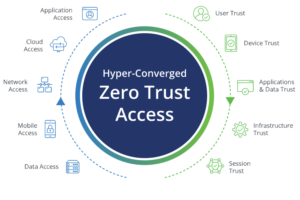Table of Contents
Introduction
You may be wondering… why would a business that focused on providing cyber security services, be providing free open source solutions and trying to help businesses do it on their own? Are we out of our mind? Do we have some sort of ulterior motive? The answer is simple: no! We are laser focused on helping businesses of all sizes to achieve a robust cyber security program, even if that means just using these tips.
Spoiler: If you’re just here for the goodies and want to see the list of open-source software, you can skip to the end (you’ll miss out on some takeaways though)!
Lets break this down into four categories; focusing on the fundamentals, automating security processes, using open-source solutions, and collaborating with peers and the local cyber community at large. So, lets kick it off!
Security Operations Center (SOC) Basics
Focus on Fundamentals: Focusing on the fundamentals of security means ensuring that your organization follows essential security practices. Conduct a thorough risk assessment to identify critical assets and potential vulnerabilities. Prioritize security measures based on the identified risks to allocate resources effectively. Emphasize the following areas:
- Patch Management: Regularly apply security patches and updates for all software and operating systems. Vulnerabilities in outdated software are often exploited by attackers. This can be done with tools like Microsoft WDT, PDQ Deploy or Chocolatey.
- Password Policies: Enforce strong password policies that require complex and unique passwords for each account. Consider implementing multi-factor authentication (MFA) for added security and using native things like Microsoft GPO to enforce these policies so you don’t have to rely on everyone’s good graces! An estimated 20-30% of all data breaches are the result of weak passwords (yikes)!
- User Access Controls: Implement the principle of least privilege, granting employees access only to the resources they require for their roles. This limits the impact of a security breach caused by compromised credentials.
Automate Security Processes: Automation can significantly improve the efficiency and effectiveness of your security operations, even with limited personnel. This includes both basic IT automations as well as Security Orchestration, Automation, and Response (SOAR). Consider the following automation strategies:
- Vulnerability Scanning: Utilize automated vulnerability scanning tools like OpenVAS to identify weaknesses in your network and systems without breaking the bank. Regular scans help you detect and fix potential issues promptly.
- Log Analysis: Employ security information and event management (SIEM) tools such as AlienVault , the ELK Stack, or even Splunk Free to automate log analysis. Centralized log management enables real-time monitoring of security events and can aid in identifying suspicious activities.
- Threat Detection: Leverage intrusion detection systems (IDS) or intrusion prevention systems (IPS) like Snort or Surricata to automate the detection of malicious network activities. These systems can alert you to potential threats and help in early threat mitigation without having someone constantly monitoring traffic.
Open Source Intelligence (OSINT) and Open Source Security Software: Open-source intelligence (OSINT) serves as a valuable resource for gathering information on potential threats, but it doesn’t stop there. In addition to utilizing OSINT for threat intelligence, small businesses can take advantage of open-source security software to actively protect their digital assets (if the recommendations above were any indication). These tools offer cost-effective alternatives to commercial solutions and can play a significant role in bolstering your organization’s security posture. At the end of this blog, I’ll list them out with links to where you can find more information.
Integrating open-source security software into your active protection strategy allows your small business to leverage community-driven solutions that are continually updated by a global community of contributors. While these tools may require some initial setup and configuration, the cost savings and potential benefits they offer make them an attractive choice for resource-conscious organizations.
Collaborate with Peers: Collaboration with other small businesses is often overlooked, but can be mutually beneficial in enhancing security for all parties. By sharing insights, threat intelligence, and best practices, you can collectively strengthen your cybersecurity posture. Cyber security is an area where more insight is better, and generally speaking doesn’t contain any “secret sauce” to give a leg up in the competition. Sharing is caring and local businesses win by growing together. Consider the following approaches:
- Local Cybersecurity Networks: Join or establish local cybersecurity networks where small businesses in the area come together to share experiences and knowledge about security threats.
- Information Sharing Partnerships: Forge partnerships with peer organizations to exchange threat intelligence and discuss security challenges. This can broaden your perspective on potential risks.
- Industry Associations: Get involved with industry associations or forums where security concerns and solutions are discussed. These platforms can provide valuable advice and support.
Remember that no security measure is foolproof, but by combining these strategies and staying proactive in your approach, you can significantly improve your small business’s security operations without breaking the bank. Regularly assess and adapt your security measures to address new threats as they emerge, ensuring your organization is well-prepared to face the evolving cybersecurity landscape.
Open Source Solutions

If you’ve stuck around this long, congratulations! Here’s a virtual cookie. You’ll also find the consolidated list of recommended open-source solutions below. If you have any other questions, please reach out to us on our Contact Us page and we will be more than happy to help!
- Snort
- URL: https://www.snort.org/
- Category: Intrusion Detection System (IDS)
- Suricata
- URL: https://suricata.io/
- Category: Intrusion Detection System (IDS)
- TheHive
- URL: https://thehive-project.org/
- Category: Security Orchestration, Automation, and Response (SOAR)
- Cortex
- URL: https://thehive-project.org/
- Category: Security Orchestration, Automation, and Response (SOAR)
- Security Onion
- URL: https://securityonion.net/
- Category: Network Security Monitoring (NSM)
- OSSEC
- URL: https://www.ossec.net/
- Category: Endpoint Security
- ELK Stack (Elasticsearch, Logstash, Kibana)
- URL: https://www.elastic.co/what-is/elk-stack
- Category: Security Information and Event Management (SIEM)
- ModSecurity
- URL: https://modsecurity.org/
- Category: Web Application Firewall (WAF)
- OpenVAS
- URL: http://www.openvas.org/
- Category: Vulnerability Assessment
- Nmap
- URL: https://nmap.org/
- Category: Network Scanning
- GnuPG (GPG)
- URL: https://gnupg.org/
- Category: Encryption and Digital Signatures
- ClamAV
- URL: https://www.clamav.net/
- Category: Antivirus and Malware Detection
- Fail2ban
- URL: https://www.fail2ban.org/
- Category: Intrusion Prevention System (IPS)
- Bro (Zeek)
- URL: https://www.zeek.org/
- Category: Network Security Monitoring (NSM)
- OpenVPN
- URL: https://openvpn.net/
- Category: Virtual Private Network (VPN)
- PFsense
- URL: https://www.pfsense.org/
- Category: Firewall and Routing
- Kali Linux
- URL: https://www.kali.org/
- Category: Penetration Testing
- OSQuery
- URL: https://osquery.io/
- Category: Host-based Intrusion Detection System (HIDS)
- Metasploit Framework
- URL: https://www.metasploit.com/
- Category: Penetration Testing and Exploitation
- MISP (Malware Information Sharing Platform & Threat Sharing)
- URL: https://www.misp-project.org/
- Category: Threat Intelligence Sharing





